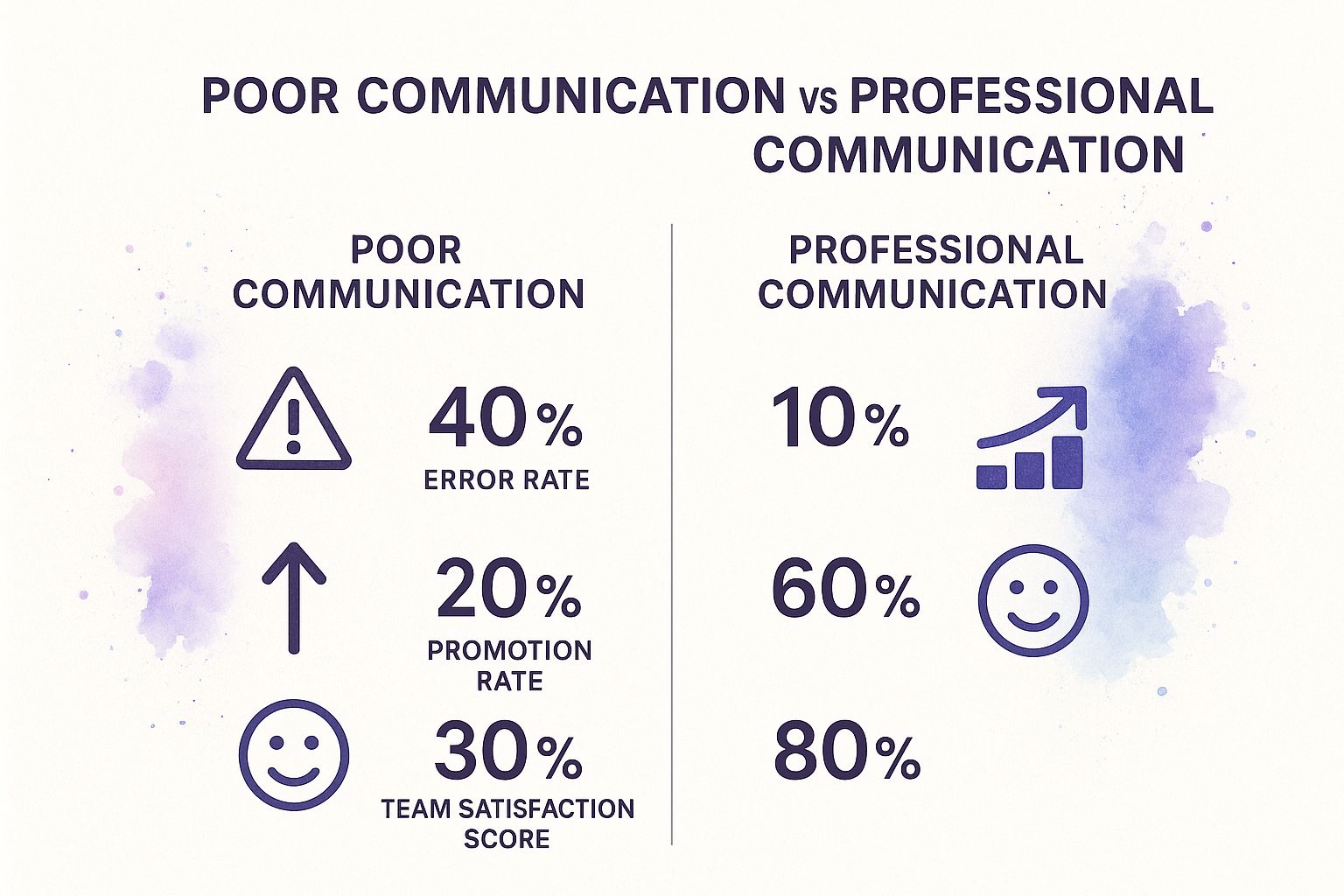How to Sound Professional in Every Interaction
Learn how to sound professional with proven strategies for your word choice, vocal tone, and delivery. Elevate your communication skills for real career growth.


The ability to sound professional really boils down to three things: clarity, confidence, and respect. It's the skill that, time and again, I've seen separate a stagnant career from one that's really taking off. When you can build trust and show you know your stuff in every conversation or email, you're already ahead of the game.
Why Your Professional Presence Matters More Than You Think
Learning to sound professional isn't just a "nice-to-have"—it's a fundamental part of moving your career forward. How you speak and write directly shapes how your colleagues, your boss, and your clients see you. Think about it: a hesitant project update can make you seem unsure, and a poorly worded email can create total confusion. Both can chip away at your authority and even bring down team morale.
On the flip side, when you communicate clearly and with confidence, you earn trust. You become a more effective leader and get real results. It’s what turns you from just another person in the meeting into a respected contributor whose ideas actually get heard. This is true whether you're running a team, presenting to executives, or just working on everyday tasks with your peers. The link between how you communicate and where your career is headed is impossible to ignore.
The Real Cost of Miscommunication
The numbers behind poor communication are genuinely shocking. In the U.S. alone, fuzzy or ineffective workplace communication is estimated to cost businesses $1.2 trillion every year. For a company of just 100 employees, that can add up to over $500,000 in losses from muddled instructions, broken workflows, and delayed projects.
Even more telling, research from Chanty.com shows that a staggering 86% of workplace failures come from a lack of collaboration or just plain bad communication. It’s the hidden culprit behind most operational headaches.
This infographic breaks down how different communication styles can directly affect things like error rates, your chances of getting promoted, and overall team happiness.

As you can see, the data makes a strong case: professional communicators don't just get promoted more often; they also help create a more efficient and positive place to work. Developing these skills is an investment in yourself and your team's success. This foundation of clear expression is essential, from high-stakes presentations to casual team check-ins. If you're looking for ways to build better team connections, our guide on conversation topics for adults has some great ideas to get you started.
Mastering Your Vocal Delivery
It’s an old saying, but it holds true: it's not just what you say, but how you say it. Your vocal delivery—your pace, your tone, the rhythm of your speech—can completely change how your message lands. Ever notice how speaking too fast can make you sound nervous? Or how a slow, meandering pace can make listeners tune out?
The trick is to find a controlled, deliberate rhythm. You want to guide your listener through your ideas, not race them to the finish line. One of the most powerful tools in your arsenal is the simple pause. A well-timed moment of silence gives your audience a beat to digest what you just said, adding a sense of weight and authority to your words.

From Hesitation to Authority
What you say matters, too. Certain words and phrases can instantly drain the confidence from your message. We often use hesitant language—like "I think maybe..." or "This is just an idea, but..."—without even realizing how much it undermines our credibility. The goal is to spot these habits and swap them for more direct, assertive language.
Stop asking for permission to share your thoughts. Instead, state them with conviction. This small shift in wording transforms you from a passive observer into a confident leader.
Small tweaks can make a huge difference. Swapping out a few common hesitant phrases for more confident alternatives will immediately change how people perceive you in meetings, presentations, and even one-on-one conversations.
From Hesitant to Confident Language
| Instead of Saying This... | Try Saying This... | Why It Works |
|---|---|---|
| "I think maybe we could..." | "I recommend we..." | It’s a clear, actionable suggestion, not a tentative thought. |
| "Sorry to interrupt, but..." | "May I add something?" or "On that point..." | It asserts your place in the conversation without apologizing. |
| "Does that make sense?" | "What are your thoughts on this?" | It invites collaboration instead of seeking validation. |
| "I just wanted to say..." | "I'd like to add..." or "My point is..." | It removes filler words and gets straight to the point. |
Making these simple substitutions is a fantastic starting point for sounding more professional and sure of yourself.
Active Listening: A Professional Superpower
Finally, sounding professional isn't just a one-way street. It's as much about listening as it is about speaking. When you practice active listening—where you’re truly focused on understanding the speaker, not just waiting for your turn to talk—you show respect and deep engagement.
This isn't just a "nice-to-have" skill. According to a recent Pumble study, recruiters are placing a massive emphasis on communication. In fact, 55% of global recruiters believe verbal communication will be the most crucial skill for job candidates in 2025, with listening skills following close behind.
If you’re looking to polish your delivery even further, our guide on how to improve your accent in English offers some great next steps.
Choosing Words That Build Credibility

The words you choose are the very foundation of your professional reputation. Think of your vocabulary as a toolkit—the right words build credibility and impact, while weak or vague language can slowly chip away at it.
The first step is often about what you remove. We all have verbal habits, but filler words like "um," "ah," and "like" can signal nervousness or a lack of confidence. Studies have even shown that relying too heavily on these fillers can make a speaker appear less competent.
Simply becoming aware of when you use them is a massive leap toward cleaner, more professional communication.
Replace Weak Language with Powerful Verbs
It's not just about filler words. Certain phrases, often called "weasel words," can sneak into our speech and water down our message. Think of terms like "sort of," "kind of," or "basically"—they sound like they're adding something, but they actually create ambiguity and reduce your authority.
The fix? Swap them out for strong, direct action verbs. This one change can shift your entire communication style from passive and uncertain to active and confident, ensuring your points land with purpose.
Vague language creates doubt. Precise language builds trust and shows you have a clear command of the subject matter, making you a more credible source of information.
Look at how a simple sentence can be transformed.
- Before: "I kind of think we should basically try to finish the report."
- After: "I recommend we finalize the report by tomorrow."
The difference is small, but the impact is huge. You've replaced uncertainty with a clear, actionable direction. For anyone new to navigating these conversations, our guide on English conversation for beginners offers a great starting point. Mastering your word choice is a skill that will pay dividends in every single professional interaction.
Adapting Your Tone Across Different Channels
Think of your professional tone not as a fixed setting, but as a dial you adjust for the situation. The way you communicate in a formal email to a new client will, and should, feel very different from how you message a teammate on Slack. Mastering this flexibility is a huge part of sounding professional.
The real skill is matching your tone to both the medium and the audience. A detailed project proposal demands a certain gravity, while a quick check-in on Microsoft Teams can be more relaxed. Getting this wrong can make you seem out of sync or, even worse, unprofessional.

This kind of adaptability is especially important when you’re communicating with people in different roles. For instance, if you don't adjust your style for employees who aren't sitting at a computer all day, you can create a real sense of disconnect.
The numbers back this up. An international study found that only 29% of non-desk employees were happy with their company's internal communication. That’s a stark contrast to the 47% satisfaction rate among desk-based workers. This isn't just a small gap; 34% of non-desk employees felt that leadership simply wasn't addressing their specific concerns. You can dig deeper into these findings in the 2025 Staffbase study.
Mastering Digital and Virtual Communication
When you’re writing an email or a message on Slack, your words have to do all the work. Without your voice or body language, it's easy for a direct message to come across as blunt. The trick is to convey both warmth and authority through your writing alone.
Here’s how to handle different channels:
- Formal Emails: Stick to the classics. Use a clear subject line, a proper greeting like "Dear [Name]," and a well-structured body. Keep your sentences clean and to the point.
- Instant Messages: You can definitely be more casual here, but don't get sloppy. Avoid obscure slang or too many abbreviations. A simple emoji can often soften a message and prevent it from sounding too abrupt.
- Video Calls: Now, non-verbal cues are back in the picture. Make a point to look at your camera when you speak to simulate eye contact. Small things like nodding or leaning forward slightly show you're engaged and listening.
The ability to move smoothly between these different communication styles is what separates the pros. It shows you have strong emotional intelligence and a solid grasp of how modern workplaces operate.
At the end of the day, it doesn't matter if you're typing a quick note or leading a major video conference. The fundamentals are the same: be clear, be respectful, and always consider who you're talking to. That thoughtful approach is what builds a consistent and strong professional presence on any platform.
A Practical Routine for Lasting Improvement
Knowing how to sound professional is one thing, but actually doing it consistently is where the real change happens. Improvement isn't about one big push; it's about building small, repeatable habits that stick. Think of it as creating a roadmap that turns theory into second nature.
The idea isn't to pile on hours of extra work. Instead, focus on short, targeted exercises that build muscle memory. You'd be surprised what even 15-20 minutes a day can do. It’s enough to create a significant, lasting shift in how you speak and write.
Lasting change is the result of daily actions, not occasional grand gestures. By integrating small practice sessions into your routine, you are programming your brain for a higher standard of communication.
This approach keeps things manageable and helps you avoid the burnout that comes from trying to fix everything at once.
Build Your Weekly Practice Plan
A simple weekly routine can be a game-changer for your professional communication skills. The trick is to mix it up by focusing on a different skill each day to keep things fresh and engaging.
Here’s a sample schedule you can steal or adapt:
- Monday (Tone Check): Record yourself in a mock meeting or just describing your day. When you listen back, pay close attention to your tone. Are you using filler words like "um," "uh," or "like"? Just noticing is the first step.
- Wednesday (Real-World Rehearsal): Spend 10 minutes role-playing a tricky conversation. This could be anything from giving constructive feedback to a colleague to presenting a new idea to your boss. Walking through these scenarios builds the confidence you need for when it counts.
- Friday (Language Immersion): Dedicate 10 minutes to reading a well-written article from a quality source like The Wall Street Journal or Harvard Business Review. Don’t just skim—notice their word choices and how they structure sentences. It’s a great way to absorb professional language naturally.
Get Some Feedback with Practice Tools
Looking at your own performance is powerful, but getting outside feedback is what really speeds things up. This is where a few good tools can make all the difference.
Platforms like Talk-Easy give you a safe space to practice speaking with an AI tutor that offers instant, friendly corrections. You can work on your delivery, vocabulary, and overall confidence without the pressure of a real audience. It’s a fantastic way to round out your practice routine.
Common Questions About Sounding Professional
Putting all this advice into practice is where the rubber meets the road. It's one thing to read about professional communication, but it's another to navigate tricky real-world situations. Let's dig into some of the most common questions and challenges that pop up when you start refining your professional voice.
My goal here is to give you some clear, direct answers to help you handle these moments with a bit more confidence. Think of this as a quick-reference guide for those "what do I do now?" scenarios.
How Can I Sound Professional Without Sounding Robotic?
This is a huge one, and a totally valid fear. Nobody wants to sound like a corporate automaton. The trick is to remember that professionalism is about clarity and respect, not about stripping away your personality.
The real goal is to cut out the distracting fluff—the filler words, the vague language—so your ideas can land with more impact. Your natural enthusiasm, your unique vocal tone, and your personality? Those are assets. Let them shine through. Authenticity is what builds real trust with colleagues and clients, after all.
The goal is to become a more polished version of yourself, not a completely different person. Professional language should be the frame for your unique ideas and insights, allowing your personality to come through in a credible way.
Think of it like this: your perspective is what makes you valuable. Professionalism just makes sure your message gets delivered clearly, making your contributions even more powerful.
What If I Feel Nervous or Intimidated in a Conversation?
When the nerves kick in, preparation is your best friend. Before walking into that high-stakes meeting or important call, take just five minutes to jot down two or three key points you absolutely need to make. This simple act gives you a mental anchor and a clear focus.
During the conversation itself, try to be mindful of your breathing. A slow, steady breath can do wonders to calm a racing mind. It also helps to shift your focus outward by using active listening. Asking thoughtful questions not only shows you're engaged but also takes the pressure off you to do all the talking.
And remember, it's completely okay to pause for a second to collect your thoughts. A deliberate, thoughtful pause sounds a hundred times more professional than rushing to fill the silence with "ums" and "ahs."
How Do I Give Feedback Without Sounding Overly Critical?
Giving constructive feedback is one of the truest tests of professional communication. To nail it without coming across as harsh or personal, I always recommend the Situation-Behavior-Impact (SBI) model. It's a lifesaver.
- Situation: First, you ground the feedback in a specific time and place.
- Behavior: Then, you describe the observable behavior you saw or heard. Stick to the facts, no judgment.
- Impact: Finally, explain the actual impact it had on you, the team, or the project.
For example, instead of saying, "Your report was really sloppy," you could try this: "In yesterday's project report (Situation), I noticed there were several data inconsistencies (Behavior). This meant we had to spend extra time verifying the numbers before the client meeting (Impact)."
See the difference? This approach keeps the feedback objective and focused on the work, not the person. It's a game-changer for maintaining a respectful and professional tone.
Ready to practice these skills in a supportive, real-time environment? Talk-Easy offers an AI-powered platform where you can build confidence and polish your professional communication in just 15 minutes a day. Start speaking more clearly and effectively by visiting the TalkEasy website today.